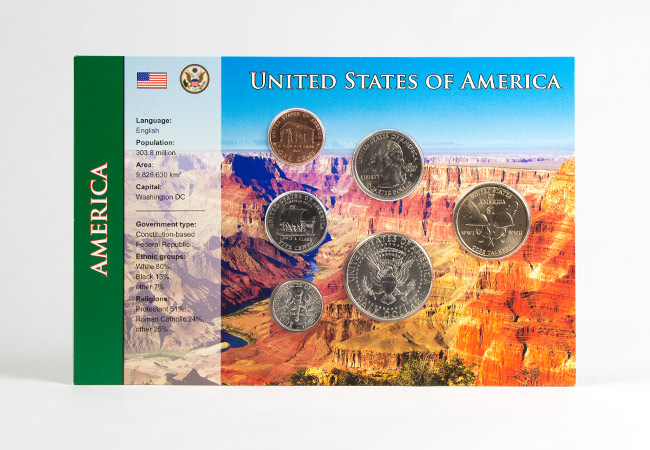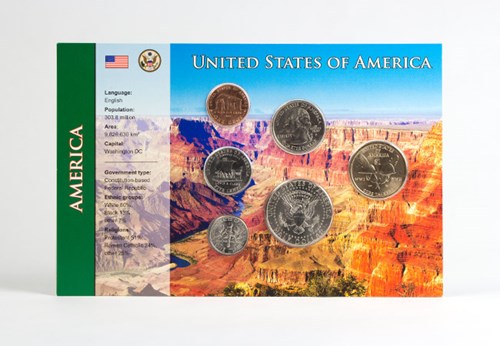Posts Tagged ‘America’
56 highly collectable US Quarters celebrate the history of America’s most beautiful locations…
In 1999, coin collecting in America was changed forever with the release of the US State Quarters series.
These coins proved so popular that almost half the US population (that’s roughly 150 million people) took part in collecting these coins and they quickly became the most widely collected in all of America, and arguably, the world!
Following this wild success, a brand new series of US Quarters was released in 2010, celebrating the beauty of America and its national parks.
US National Park Quarters Complete Set
Each stunning reverse design captures the magnificence and history of America’s most beautiful locations, whilst the obverse features a smaller restoration of the original Washington quarter portrait.
5 new National Park Quarters were released each year from 2010 to 2020, with a final design issued in 2021 to complete the series of 56 coins.
But, these quarters were minted and released for only 10 weeks each before never being produced again, making the series particularly sought after…
What’s more, this second series of US Quarters has been released in significantly lower numbers, with a total mintage just over HALF that of the highly sought-after US State Quarters series!
And, with a significant proportion of these coins now taken out of circulation into private collections, they are sure to become scarcer than ever, meaning collectors will want to act fast to avoid missing out on the complete collection.
American coinage is one of the most competitive coin collecting markets in the world… Read on to find out more about some of America’s most infamous coins!
Indian Head Penny (1859-1909)

The Indian Head Penny is famous for celebrating Native Americans, but it actually doesn’t show a Native American.
According to legend, designer James B. Longacre used a portrait of his 12 year old daughter, Sarah, wearing a headdress. It is, however, more likely that the portrait was based on a classical Greco-Roman statue Venus Accroupie (Crouching Venus).
Either way, the ‘Indian’ is not a Native American! The obverse features the head of Lady Liberty wearing a headdress, while the reverse depicts a wreath as well as the words ‘One Cent’ and a shield in the middle at the top of the coin.
Morgan Silver Dollar (1878-1921)

For the new silver dollar, designer George T. Morgan decided to portray Liberty as a goddess, inspired by Philadelphian school teacher, Anna Williams who had a fair complexion, Grecian nose and golden hair. Morgan eventually persuaded Anna Williams to sit as the model for Liberty for the obverse of the Morgan Silver Dollar.
In 1878 artists’ models were considered immoral, therefore, Morgan publicly stated that the model was a statue in a Philadelphia museum. Word soon leaked out, however, and it is rumoured that Williams was fired from her teaching job!
‘No Cents’ Liberty Head Nickel (1883)

When the new Liberty Head Nickel was issued in 1883, the denomination was nowhere to be seen, instead a large ‘V’ (Roman ‘5’) was on the reverse.
The coins were the size of the $5 gold coin in circulation at the time which created an opportunity for unscrupulous crooks who came up with a cunning plan to pass them off as $5 by gold plating the new nickels and cutting reeds into the edge by hand. The U.S Mint soon became aware and within a few weeks the design was changed to include the word ‘Cents’ under the ‘V’. The ‘No Cents’ coins are also known as ‘Racketeer’ Nickels.
Lincoln Penny (1909)

Designer Victor David Brenner added his ‘VDB’ initials to the new Lincoln Penny design in 1909 which was issued to commemorate the 100th anniversary of Abraham Lincoln’s birth.
While the public generally loved the Lincoln cent when it was first released, they didn’t like the prominence of Brenner’s initials. The U.S. Mint quickly removed the initials as it appeared as though Brenner was either boasting or advertising. This was the first cent to feature Abraham Lincoln’s motto ‘In God we trust’ on the obverse.
Morgan Dollar (1921)

When notorious outlaws Bonnie and Clyde were shot and killed by police in 1934, a 1921 Silver Morgan Dollar was recovered from the jacket of Clyde Barrow among other possessions. The outlaw lovers were believed to have committed 13 robberies among other felonies between 1932 and 1934.
The hunt for the duo captured the nation’s imagination during the Great Depression and their fame was heightened by their practice of leaving glamourous photos of themselves at crime scenes.
Even more so now, the 1921 coin is forever associated with Bonnie and Clyde.
Roosevelt Dime (1946)

In 1945 plans were quickly laid for the introduction of a new coin to honour Roosevelt after his passing. The task was assigned to John Ray Sinnock and coinage began in 1946. Controversy soon arose because sculptor Selma Burke claimed that Sinnock had stolen her design without giving her credit, however Sinnock strongly denied this.
In addition, conspiracy theorists claimed that Sinnock’s initials ‘JS’ (at the base of Roosevelt’s neck) actually referred to Russian leader Joseph Stalin because of Roosevelt’s supposed ‘communist’ learnings.
These are just some of the incredible American coins that have been issued over the decades, including the 56 US National Park Quarters!
Have you ever seen these coins before? Let us know in the comments below!
Secure the Complete US National Park Quarters Set!
Through our contacts in the US we have managed to secure a limited amount of complete sets for our collectors, to ensure you have the opportunity to include this impressive set in your collection.
All 56 US National Park Quarters will come presented in a custom display folder, including a map to pinpoint each quarter in the series. This really is the perfect way to display your collection and preserve all 56 coins for generations to come.
Don’t miss your limited opportunity to secure this iconic collection and order yours today >>
America’s most infamous coins…
Every coin tells a story. But few more than America’s eight most notorious coins…
The U.S. collectible coin market can be an absolute minefield and is one of the most competitive coin collecting markets in the world.
Some of the most collectible coins date back to the 1800’s and are extremely famous. Let me tell you why…
Indian Head Penny (1859-1909)

The Indian Head Penny is famous for celebrating Native Americans, but it actually doesn’t show a Native American.
According to legend, designer James B. Longacre used a portrait of his 12 year old daughter, Sarah, wearing a headdress. It is, however, more likely that the portrait was based on a classical Greco-Roman statue Venus Accroupie (Crouching Venus).
Either way, the ‘Indian’ is not a Native American! The obverse features the head of Lady Liberty wearing a headdress, while the reverse depicts a wreath as well as the words ‘One Cent’ and a shield in the middle at the top of the coin.
Morgan Silver Dollar (1878-1921)
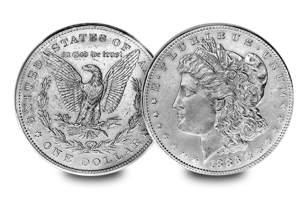
For the new silver dollar, designer George T. Morgan decided to portray Liberty as a goddess, inspired by Philadelphian school teacher, Anna Williams who had a fair complexion, Grecian nose and golden hair. Morgan eventually persuaded Anna Williams to sit as the model for Liberty for the obverse of the Morgan Silver Dollar.
In 1878 artists’ models were considered immoral, therefore, Morgan publicly stated that the model was a statue in a Philadelphia museum. Word soon leaked out, however, and it is rumoured that Williams was fired from her teaching job!
‘No Cents’ Liberty Head Nickel (1883)
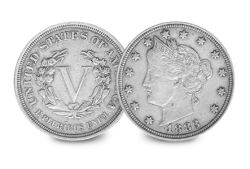
When the new Liberty Head Nickel was issued in 1883, the denomination was nowhere to be seen, instead a large ‘V’ (Roman ‘5’) was on the reverse.
The coins were the size of the $5 gold coin in circulation at the time which created an opportunity for unscrupulous crooks who came up with a cunning plan to pass them off as $5 by gold plating the new nickels and cutting reeds into the edge by hand. The U.S Mint soon became aware and within a few weeks the design was changed to include the word ‘Cents’ under the ‘V’. The ‘No Cents’ coins are also known as ‘Racketeer’ Nickels.
Lincoln Penny (1909)

Designer Victor David Brenner added his ‘VDB’ initials to the new Lincoln Penny design in 1909 which was issued to commemorate the 100th anniversary of Abraham Lincoln’s birth.
While the public generally loved the Lincoln cent when it was first released, they didn’t like the prominence of Brenner’s initials. The U.S. Mint quickly removed the initials as it appeared as though Brenner was either boasting or advertising. This was the first cent to feature Abraham Lincoln’s motto ‘In God we trust’ on the obverse.
Morgan Dollar (1921)
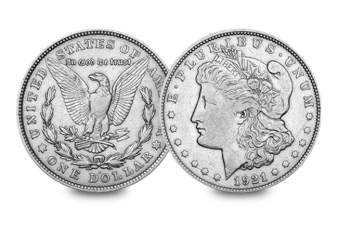
When notorious outlaws Bonnie and Clyde were shot and killed by police in 1934, a 1921 Silver Morgan Dollar was recovered from the jacket of Clyde Barrow among other possessions. The outlaw lovers were believed to have committed 13 robberies among other felonies between 1932 and 1934.
The hunt for the duo captured the nation’s imagination during the Great Depression and their fame was heightened by their practice of leaving glamourous photos of themselves at crime scenes.
Even more so now, the 1921 coin is forever associated with Bonnie and Clyde.
Roosevelt Dime (1946)

In 1945 plans were quickly laid for the introduction of a new coin to honour Roosevelt after his passing. The task was assigned to John Ray Sinnock and coinage began in 1946. Controversy soon arose because sculptor Selma Burke claimed that Sinnock had stolen her design without giving her credit, however Sinnock strongly denied this.
In addition, conspiracy theorists claimed that Sinnock’s initials ‘JS’ (at the base of Roosevelt’s neck) actually referred to Russian leader Joseph Stalin because of Roosevelt’s supposed ‘communist’ learnings.
Franklin Half Dollar (1948)
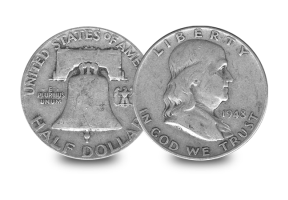
The Franklin Half Dollar was designed by John R. Sinnock and his ‘JS’ initials were again seen by conspiracy theorists as a tribute to Joseph Stalin.
In addition, the crack on the Liberty Bell was controversial, some people saw it as a statement that Liberty in the United States was under threat (despite the fact that the image exactly reflects the bell’s appearance).
Finally, what appears to be a small ‘o’ and large ‘F’ on the reverse (‘oF’ in the United States of America) was rumoured to be a mistake and that the Mint would recall all 1948 coins to correct the ‘error’.
Anthony Dollar (1979)
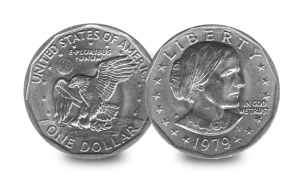
The Anthony Dollar was revolutionary – the first circulating coin to feature a historical woman. Susan B. Anthony was an author and protest speaker among other titles but best known as President of the National American Suffrage Association. The coin was also the first small-sized Dollar that was issued for wide circulation.
However, it quickly became notorious – and almost universally rejected – because it was the same colour and about the same size as a quarter. Therefore, it was often mistaken for a Quarter, and the public refused to use it! (Interestingly, it is now a sought-after collector’s item.)
For me, one of the best things about coin collecting is the story behind the coin and I’m sure you’ll agree that these coins from America have some truly fascinating stories to tell.
Discover the coins from the USA
Today you can secure for your collection the coins your fellow American Change Checkers are collecting, from 1 cent to 1 dollar!
Five Fun Facts about US coins for American Independence Day!
Today is American Independence Day and we thought there could be no better way to join in the 4th of July celebrations than to share five fun facts you might not know about US coinage!
1) The reverses are struck upside down.
Did you know that on US coins, the reverses are stuck upside down? This is arguably due to the fact that originally, the Mint wanted to differentiate their coins from their medals. The medals’ faces are struck with the same orientation as they are supposed to be worn, and therefore when rotated, still show an upright image.

Upside down reverses. Credit: coincommunity.com
2) By law, US coin designs must give “an impression emblematic of liberty.”
The USA, as a nation, are well known for being one of the most patriotic countries in the world. They uphold strong values of liberty and freedom, from everyday life to sporting events and even on their coinage! As a result of this, US coin designers are legally required to display an impression emblematic of liberty in their coin designs.

Statue of Liberty, a true symbol of patriotism.
3) The coinage act of 1792, establishing the U.S. Mint, made defacing, counterfeiting, or embezzling of coins by Mint employees punishable by death.
The death penalty is still legal in 31 US states and the coinage act of 1792 is still in place today. This states that any Mint employee caught defacing, counterfeiting or embezzling coins can be, in theory, sentenced to death. Whether or not this would be upheld in today’s court of law is debatable.

Defaced coin. Credit: pinterest.co.uk/crumley1065/the-coin-box
4) Origin of the “buck”.
This well-known slang term for an American dollar is thought to have originated in the early US frontier days when the hide of a male deer (a buck) was common currency, due to the scarcity of coinage. The term has since been adopted into everyday language and certainly seems to be here to stay for a while!

Buck. Credit: state.nj.us
5) The U.S. Mint’s coin production has grown over 131,000,000% since production first started in 1793.
The US Mint’s operation has grown and advanced greatly since the first mintage in 1972, when production consisted of 11,178 copper cents. Today the Mint produces an average of 14.7 million coins per day. The first mint in Philadelphia actually used horses to drive the machinery, whereas today, much more modern techniques are used and greater numbers of coins can be produced.
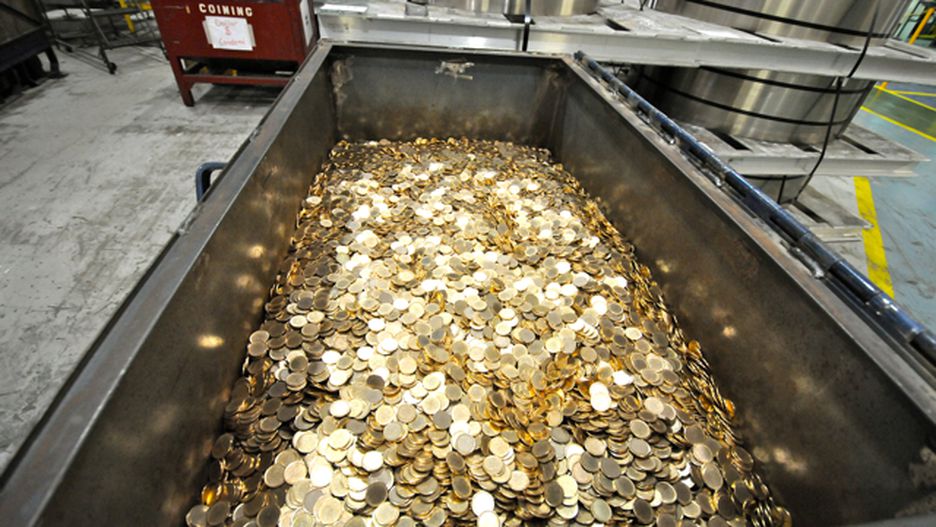
So there we have it, five fun facts about US coinage! Whether they come in handy at your next quiz night, give you something interesting to bring up in conversation, or even spark your interest in collecting US coins, we hope you’ve enjoyed finding out more about US coins.
Own the US Coin Pack today!
If this has sparked your interest in US coins, why not own the coin pack containing 6 US coins from the 1 Cent to the 1 Dollar? Each coin is protectively encapsulated in display packaging with an image of the iconic Grand Canyon and additional information about the USA and their coinage.



